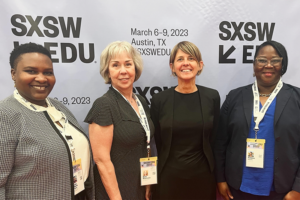The Luminary Labs team’s top takeaways from SXSW EDU 2023.
This month, the Luminary Labs team was at SXSW EDU, an annual event that brings together “the learner, the practitioner, the entrepreneur, and the visionary to share their groundbreaking stories, tackle complex issues, and build reimagined paths forward.” We attended sessions on topics like education R&D, education infrastructure, and building the space workforce. And this year, we also organized a session of our own to share the story behind CTE CyberNet, a national cybersecurity professional development initiative designed and managed by Luminary Labs on behalf of the U.S. Department of Education.
This wasn’t our first time at SXSW EDU, and it won’t be our last. Aside from thought-provoking sessions on the biggest questions and ideas in the future of work and education, we also love meeting with partners and taking the pulse on the education sector — all while enjoying Austin’s legendary tacos. The conversations that happen at this event impact millions of teachers and students across the United States, and the initiatives and ideas that gain traction play a major role in bringing prosperity and opportunity to communities in every corner of the country.
Those tacos don’t travel well, but we came home with fresh insights to share. We’ve curated five top takeaways from SXSW EDU conversations — on the stage and beyond.
It’s time to turn up the volume on education R&D.
A “DARPA for education” has been in the works for years, but is gaining momentum with new federal funding. This is great news for education, but will require greater engagement with those on the ground.
For starters, the term R&D does not resonate with educators — many of whom do not see how it relates to their day-to-day work and may be wary of how approaches typically associated with defense and scientific discovery could be relevant to their classrooms. This is exacerbated by the disproportionate amount of “R,” at the expense of “D”; there are limited resources, incentives, and infrastructure for taking learning-science breakthroughs out of the “lab” (small-scale pilots), developing and refining at mid-scale, and securing buy-in and investment to scale across states and regions.
To realize the potential of these new investments, the U.S. will need to expand awareness of education R&D benefits and find ways to engage teachers, administrators, and district staff in these efforts. The Alliance for Learning Innovation — a new cross-sector coalition — is coalescing efforts to advocate for increased investments and strategies that support education innovation.
→ Go deeper with a recording of an SXSW EDU session on education R&D and the Alliance for Learning Innovation’s policy recommendations.
Schools can’t be separated from the communities in which they operate.
The COVID-19 pandemic demonstrated how learning can happen outside of schools, but it also emphasized the vast inequities in digital and social infrastructure across communities. One of the biggest themes at this year’s conference was how to better integrate schools into their communities — and in turn, how to better integrate communities into schooling.
Sessions highlighted a range of locally driven initiatives, in which a broad range of stakeholders — from students and their families to educators and industry — have been engaged in helping design and implement solutions.

Pictured from left to right: Lisa-Marie Pierre, Ph.D., Senior Open Innovation Associate at Luminary Labs; Kim Muschalek, Director, CIS/Computer Science Department at San Antonio College; Ashley Greeley, NCAE-C PMO Pathways Project Lead at the National Security Agency; Robbie Harris, Assistant Principal at St. Philip’s Early College High School
Examples included community engagement committees across Kentucky, as well as career and technical education (CTE) programs in West Alabama that provide medical training for students. Our own CTE CyberNet, a national initiative supported by multiple federal agencies, also hosted a panel discussion on its localized approach to high school CTE cybersecurity teacher professional development.
To build on these bright spots, communities will need to expand common perceptions of educational “infrastructure” — prioritizing solutions that engage school communities, foster greater connections between education and industry, and leverage existing community assets.
→ Go deeper with the Siegel Family Endowment’s Schools as Community Infrastructure report and the Stanford d.school’s K12 Futures website. The Rural Tech Project and CTE Cybernet, both designed and managed by Luminary Labs on behalf of the U.S. Department of Education, engage educators in creating and adapting programs for their own local communities.
Credentials are gaining momentum.
Discussions about degree inflation and alternative pathways have been gaining traction over the past few years, and speakers brought this topic to the fore at SXSW EDU. Sessions highlighted initiatives such as Question the Quo, Tear the Paper Ceiling, and Build, which are attempting to decouple career competency and success from college degrees. These initiatives have the potential to simultaneously address ongoing talent shortages and persistent equity gaps.
But to be successful, efforts focused on skills and credentials need widespread support from industry, funders, and policymakers. One way to do this is for employers to take a skills-first approach to hiring practices, removing bachelor’s-degree requirements when appropriate, sourcing candidates from a broader range of places, and building pathways for internal mobility. Another way to do this is to provide guidance and incentives that make it easier for employers of different sizes and in different locations to offer work-based learning opportunities.
Questions about education outcomes were also front and center in vibrant discussions around K-12 assessment — specifically, how to make it more representative of reality, personalized to learners, and useful for teachers. Frustration with the status quo could be channeled to accelerate innovation in assessments: As Pamela Paek asked, “If we know we’re going to teach to the test, why can’t we make tests worth teaching to?”
→ Go deeper with recordings from SXSW EDU sessions on the paper ceiling and K-12 assessments of the future, as well as STARs’ skill-based hiring playbook for employers.
Students and teachers need more mental health support.
Even in sessions that were not explicitly focused on mental health, speakers referenced the mental health crisis and its impact on education, connecting the need to improve student well-being with everything from school infrastructure and flexible credentialing to safety in schools and the role of educators in supporting mental health.
Teacher burnout was also a common topic of conversation. In a panel moderated by U.S. Secretary of Education Miguel Cardona, Paul Quinn College President Michael Sorrell emphasized the need to support teachers of color, who are often expected to lead school-wide diversity, equity, and inclusion efforts, and to connect with students who look like them.
While many speakers acknowledged the critical role teachers play and the need to address burnout, few offered solutions for widespread concerns about teacher burnout. A few things are certain: The conversation about burnout should be connected to discussions about teacher recruitment, training, salaries, and recognition; and for solutions to be effective, they can’t create more work for teachers.
→ Go deeper with the Nest Foundation’s You Belong Here curriculum and Educators Thriving’s educator and system supports.
New classroom technology requires thoughtful design and implementation.
ChatGPT was mentioned in many sessions, with comments oscillating between fear and hope for its potential in education. Sessions also showcased other ways of bringing media and technology into the classroom — including podcasting, film, and music production.
New technologies like artificial intelligence and machine learning have the potential to accelerate student learning. Importantly, they could also save teachers time (and help to address burnout) by automating or streamlining parts of the job so they can focus on deeply human activities like solving problems and building relationships. To be sure, the benefits of classroom technology will only be achieved through thoughtful design and implementation. This includes accounting for adequate school and community infrastructure, as well as tech ethics and teacher capacity. As Kate Ballinger from Firework Ventures said, “As an investor, I think about where we need to plug in [to improve existing systems] versus break in [to fundamentally change policy and systems].”
→ Go deeper with the U.S. Department of Education’s National Educational Technology Plan, Project Unicorn’s interoperability tools, and a recording of a SXSW EDU session on community-designed edtech.
Photo at top by Keira Burton.





